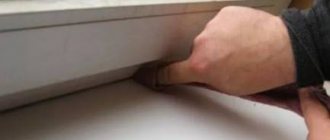Why you need to remove mosquitoes in the fall
Why you need to remove mosquitoes in the fall
- In snowy weather, snow gets inside the cells. It can turn into frost, which will tear the cells apart.
- Under the weight of snow and ice, the mosquito sag. It won't necessarily damage it, but there is a risk. Strong winds also damage the canvas.
- At low temperatures, handles may crack and break. It will be more difficult to dismantle the structure.
- Birds can damage the mesh; they cling to it with sharp claws and rip it apart.
- Over the summer, a lot of dust will accumulate on it. Leaving the window in this form is simply unsightly, and dirt reduces the shelf life of the product. That is, dismantling is needed to clean the structure and the glass unit.
- Much less light comes through the glass with mesh, but winter time doesn’t offer sunny days anyway.
- Snow and rain contribute to the appearance of rust on the holders.
- If the product is under warranty and damaged by frost or ice, it will not be repaired free of charge. Because the operating conditions have been violated.
As you can see, it is very easy to ruin a product by leaving it on the window. Maybe it won’t tear completely, but the cells will be deformed and insects, fluff, and dust will get into the apartment through them. Therefore, we advise you to still remove the mosquito net in the fall. Use the instructions and video from the article to do it quickly and correctly.
A simple and reliable mosquito net: should I remove it for the winter?
Photo from the site: moskitok.ru
Modern designs of plastic and metal-plastic windows imply a wide variety of functions, they are reliable, strong, durable, can open in various directions, perfectly retain heat in the house, and also prevent dust, dirt, and the noise level is significantly reduced. One of the truly useful design elements is considered to be a mosquito net, which, in fact, is not part of the window structure, but has many useful and important functions.
When wondering when to remove a mosquito net for the winter, you should think carefully, then everything will fall into place. Experts on this issue have a very clear opinion: if you live in an area somewhat remote from the tropics, then the mosquito net must be removed during the cold season so that it will last longer and will not become unusable ahead of time. It is best to do this at a time when the annoying mosquitoes have already fallen asleep for the winter, that is, when the ambient temperature drops below ten degrees Celsius.
In the summer, installing such a net will help you open the doors calmly and not worry that a huge number of different insects will fly into the room. This mesh also significantly reduces the amount of dust entering the room from the street. The mesh is most often installed by the craftsmen who install the windows themselves, but you can easily install it yourself, and without much effort. But is it necessary to remove mosquito nets for the winter, and what is the point of such a procedure, although not very troublesome, but still time-consuming? In fact, of course, there is a point, and it is worth listening to the opinion of professionals.
So is it necessary to remove the mosquito net for the winter, and does it make sense to leave everything as is? Many people believe that nothing bad will happen to it, even if it overwinters where it was installed, that is, attached to the window frame, but this opinion is wrong, because consequences can occur, and the mesh may even fail and after wintering you will simply have to buy a new one. Let's figure out why you need to remove mosquito nets for the winter, and why you should always keep an eye on this issue.
Photo from the site: iamprofi93.ru
- During snowstorms and blizzards in winter, snow drifts straight through even very small mesh cells into the interior, and maybe quite a lot. During the day, when even the winter sun warms up a little, this snow easily turns into ice, and the water, expanding, is quite capable of tearing the mesh cells.
- The weight of snow and ice, even if the material has withstood it and does not break, can cause the mesh to sag significantly. Of course, this will not interfere with its functionality at all, but the appearance of your window will leave much to be desired.
- From constant exposure to frost and thaw, the handles of a mosquito net can lose their strength and become brittle and brittle. Often they simply burst or even break off completely, and then removing and installing the mesh will become a real problem.
- In winter, when going in search of food, birds, for example, sparrows and titmice, can cling to your net with their sharp claws. Then gaps and holes form in the material, through which not only dust and dirt will then enter the apartment, but also the same annoying insects.
- Squally, strong winds inherent in our climate zone can easily break and even tear down a sect if it freezes and becomes hard as stone.
- The profile itself, as well as the handles of the mesh, are most often made of polyvinyl chloride, which does not withstand regular exposure to low temperatures. After three or even two years, the profile of the mesh frame may also crack, deform, or even burst completely, and then repairing it will be problematic, if not impossible.
General recommendations for dismantling
General recommendations for dismantling
- Remove the structure in calm, dry weather. A gust of wind can tear it out of your hands; if it falls, the product will most likely break. Well, the rain will just drip on you, which is unpleasant.
- Do not lean on the canvas, as it is not fastened securely enough to support a person’s weight.
- Ask someone to help you - to back you up. Some mosquitoes can be removed only by leaning outside.
- Do not press too hard on the product - the plastic parts are fragile and easy to break.
- After dismantling, wash and dry the structure. Store it in a dry, warm place - preferably in a horizontal position. Do not lean other things against it to avoid damaging the cells.
So, having chosen a good day, you can start dismantling. The method depends on what kind of mesh you have installed and how it is attached to the frame.
Rules for caring for mosquito protection
Install the product on different fasteners. But the care for them is the same. Follow these tips:
- The mesh fabric loses its elasticity over time. It breaks even under small mechanical loads. Manufacturers recommend changing the cellular structure every 5-7 years.
- You can extend the service life of the structure if you dismantle it for the winter. Modern mosquito nets are equipped with aluminum sheeting, which is not designed for use at low temperatures. Because of this, the mesh is deformed. It is advisable to remove the product in October and put it back on the window in March. Neither the profile nor the perforated sheet itself will freeze. So the service life is extended.
- If you missed the time to remove the mesh from a plastic window, you can hide the mesh in winter. But do not do the work at sub-zero temperatures, as the frame freezes and is difficult to remove from the window opening. The product can be easily broken.
- Afterwards, the element is washed with a sponge and soapy water, gently cleaning the mesh from dirt and dust particles. The window element must be dried in a dry, warm room. If the windows face the roadway, then clean the canvas once every 2-3 months. There is no need to wash the fasteners.
- The product is not intended to be dropped. Even the Anti-Cat can handle animal weights up to 5 kg. It is advisable to open the sash for ventilation to avoid the pet falling.
| ADVICE. To protect children from falling, it is necessary to install a lock on the window. To do this, install a special handle with a key and a lock on the bottom of the frame. This will allow you to ventilate the room and will additionally protect you from turning the sash with children's hands. The exception is the Anti-Cat mechanisms, but they will withstand the weight of a well-fed animal and a very small child. Therefore, it is better to play it safe. |
After reading our recommendations for installing a mosquito net at home, you can choose the appropriate option for yourself. You can watch a video on the Internet where the installation mechanism is shown in detail.
How to remove the frame mesh
How to remove the frame mesh
In most cases, the frame can be pulled out from the inside. This is a rectangle with a plastic or metal profile, inside which mosquito protection is stretched. There are four types of frame mounting. Let's talk about each of them.
Pockets and Z-shaped holders
Pockets and Z-shaped holders
It is easy to remove such a mesh yourself, provided that the fastenings are in good condition. In this case, you need to work in this order.
- Remove all things from the windowsill - they will interfere with you.
- Take the structure by the ears and lift it up - it should come out of the lower brackets. As a rule, the ears are located in the middle.
- Move the bottom of the canvas slightly towards the street. Proceed carefully.
- Lower the blade down a little to release it from the top brackets.
- Turn the product so that it fits freely into the window opening.
Ready. All that remains is to bring it into the room or onto the balcony, clean it and find a storage place.
Hooks
Hooks
Sometimes, instead of the usual holders, hooks are installed on the profile. They are attached to self-tapping screws or self-tapping screws.
- Loosen the hooks.
- Turn them inwards.
- Remove the mosquito from the window opening by the handles.
Plungers
Plungers
This mount is stronger than the others. Pins with springs or plungers are inserted into the holes of the profile and secure the blade to the frame. To dismantle it, you need to first pull out the pins at the bottom of the profile, and then at the top. Or use the second method.
- Turn the pins clockwise.
- Remove them from the frame.
- Turn the mosquito so that it enters the opening and bring it into the room.
Do not turn the fasteners counterclockwise to avoid breaking them.
Flag mounts
Flag mounts
If the canvas has flags (wings), it will be a little more difficult to remove it, because the flags are often folded not only from the inside, but also from the outside.
- Open the second flap to get to the flags.
- Turn them around.
How to remove a sliding structure
How to remove the mesh from the inside of a plastic window if it is sliding? This structure is attached using two guides along which it moves. To remove it, we do the same as with the frame.
- Clear the window sill of things so as not to drop them during the dismantling process.
- Raise the canvas.
- Release the rollers and move the lower part to the side, away from you.
- Lower down a little to remove the item from the top rollers.
There are also pleated ones. They are more compact, easy to use, and can be removed like sliding ones.
How to remove the mesh on the frame
The mesh on the frame is a quadrangular structure made of metal or plastic profile elements, between which a mesh fabric is stretched. It is attached to the window in one of three ways: using corners (PVC or metal), pockets, and flag fasteners. Fastening is done by the corner parts from the outside.
This mesh is removed by lifting it by the plastic handles while simultaneously tilting the lower part away from the frame. After the lower corners are released from the fastenings, the frame can be grabbed with one hand at the bottom and, turning horizontally, brought into the room.
The product with mounting angles placed on the frame is dismantled in the same way - the structure is lifted, tilted and removed from the fastenings.
The mesh is easily removed with fastening in the form of hooks (the hooks are located on the mesh and, when fixed, cling to the window profile from the inside of the room). When lifting and tilting the frame, the mosquito protection is easily separated from the window. The fasteners themselves cannot be removed from the frame.
Dismantling the mesh on the plungers
Plunger fastening
When fixing a mosquito net with plungers, such fastening can be considered the most reliable option; dismantling one fixed in this way will be more difficult. To do this, first of all, two plungers are simultaneously pulled out from the lower profile. Next, slightly extending the structure, the upper plungers are pulled down. It is easier to do the work with an assistant who will hold the frame so that it does not fall.
In some cases, the plunger fasteners come out of the holes along with the mesh without additional effort.
How to remove sliding nets
Sliding-type insect screens are attached to the window using a special guide, which simultaneously acts as a rail along which the structure moves. The product may have one or two guides, which are placed at the top and (or) bottom of the frame. To remove such a mesh, lift it so that the roller comes out of the guide recess. Then the structure is lowered and removed from the window.
A pleated mosquito net is one of the sliding options. It is more compact and folds conveniently when opened. The structure should be dismantled in the same sequence as a regular sliding mesh.
Installation of a sliding mosquito net.
Along the entire horizontal profile of the frame, special aluminum guides, let’s call them rails, are attached to this frame from above and below with self-tapping screws.
The mesh is installed between these rails, rests on the lower rail, and moves along it; the upper rail acts as a clamp/holder. From the described installation principle it is clear that in order to install the mesh, the upper and lower frames must be free, i.e. the upper frame should not be covered by the ceiling, and the lower by the window sill. You should see a 32mm profile at the top and bottom; if less, then you cannot install a sliding mosquito net. But, sometimes, you can install a regular removable frame mosquito net. To determine the possibility of installation, you need a visit from a specialist or a photo: 1. general view from the inside, 2. connection of the frame to the ceiling and window sill at the intended installation location, 3. size (in mm) how much of the frame (top and bottom) is left uncovered, 4. what is used (what material) for the window sill and ceiling.
Installation of a sliding mesh.
If the sliding mosquito net is installed correctly, then this is a very simple process: the top of the net, with a special groove, is put on the top rail, i.e. the rail fits into the groove, we put the lower part of the mesh with the groove onto the lower rail. We remove it like this: We lift the mesh from the bottom rail, move the bottom of the mesh slightly towards ourselves and lower the mesh. All the mesh has been removed. As mentioned above, the upper and lower connecting corners of the sliding mesh are different; at the bottom there are connecting corners with rollers, at the top without them. If the mesh is turned over, it will not be possible to install it; the mesh will not adhere to the upper guide and will fall. Therefore, if before the mesh stood normally, but after washing it began to fall, then you mixed up its top and bottom. Turn the grid over.
Problems with removing/installing a sliding mosquito net and their solutions.
Since aluminum glazing, unlike plastic, is not “warm”, the installation is carried out with less quality. And, sometimes, the difference in frame height can reach 1.5 cm. Therefore, if you are unable to remove the mesh using the method described above, find the highest place (the place where the distance between the upper and lower rail is highest) and try to do it there . If this does not help, then you will have to unscrew several screws from the lower rail, but, again, in the highest place. After installing the mesh, screw them into place.
Advantages and disadvantages of sliding mosquito nets.
Advantages:
* No need to rent for the winter. * Metal fastenings (rails) - will not break. * Easy and quick to open - convenient for smokers. * Possibility of use on those sashes that are needed at the moment. * A sliding mosquito net is useful when the final finish of the loggia and which door will be used for ventilation in the future are unknown. But you should know that if there are more than two sliding doors on the loggia, then by moving the mesh, it will be possible to reliably close the opening from the penetration of insects only on the internal doors (provided that the size of the doors is the same). By moving the mesh to close the opening of the outer sash, a gap will inevitably form (2-3 cm in size between the mesh and the outer sash) to the right or left of the mesh along its entire height, through which insects will certainly penetrate.
Flaws:
1. If the balcony ceiling is already covered with clapboard, plasterboard, etc., then it will most likely be impossible to use this installation method.
bottom rail not installed top rail not installed
You can install the bottom rail here
Accessories for a sliding mosquito net: connecting corners, felt.
Connecting corners (plastic) are placed inside the aluminum frame and fastened into it by surprise, using a hexagon screw built into the corner. To replace them (in case of breakage), the mesh must be disassembled. There are no upper and lower corners, they are all the same and cast in such a way that different sides of the same corner are used for the top and bottom. They can be with or without a roller (sliders).
To ensure a tight fit of the mesh to the balcony frame, in order to exclude the possibility of insects entering the room, felt is installed around the perimeter of the mesh. It can be plug-in (standard) - 5x12mm, and self-adhesive - 7x11mm. Both can be installed/replaced without disassembling the mesh.
Repair of a sliding mosquito net: - replacement of the canvas 750 RUR/m 2, but not less than 750 RUR/net, - replacement of the corner (with a roller, including its cost) - 250 RUR/piece, - impost (you can’t do without it) - 100 RUR/piece, - minimum cost of work - 2000 rubles, - buy a corner (with a roller) - 70 rubles. — felt (inserted, gray, 5x12mm) — 25 rub/m.p. — felt (self-adhesive, beige, 7x11mm) — 45 RUR/m.p.
Cost of a sliding mosquito net. Measurement, production, delivery, installation - 4000 rubles/m2, but not less than 4000 rubles/mesh. The minimum order value is RUB 4,200.
Clean the mosquito net with dish soap
There is no need to look for a special detergent in stores; this venture is unlikely to be crowned with success. Also, you should not use glass spray: it evaporates too quickly, no dirt will have time to become limp. Dishwashing detergent is one of the best options that neither grease, nor dust, nor old dirt can resist.
Some people at home practice washing the mosquito net directly on the window, but this is not the best way. When rinsing, a huge amount of dirty water flows out. With this approach, stains on slopes, window sills, and wallpaper cannot be avoided. Removing the mesh is simple: just lift it up so that the frame comes out of the pocket, then pull it towards you. Even the most fragile housewife can cope with this.
What do you need:
- soft brush;
- 2 tbsp. l. dishwashing detergents;
- 1 liter of water for solution;
- towel or rag.
Step-by-step instruction:
- Dilute dish soap in warm water and lightly whisk the solution until foam forms.
- We send the mesh to the bathtub or shower stall and place it vertically with a slight inclination. In summer, you can use a large basin outside. To fix the position, place a rag or towel on the bottom.
- Apply the foam solution with a brush. Leave for 10-15 minutes - let the dirt soak. Then we lightly walk over the surface, without pressing.
- Now take a shower head or just a ladle of water and wash off the soap solution. This cannot be done under strong pressure without a sprayer.
There is no need to rush to return the mosquito net to its place; let it dry completely. Otherwise, dust, fluff and pollen, and small specks will quickly stick to the wet surface.
Types of balcony mosquito nets
Frame mosquito nets
This type of mesh is most popular among consumers, as they are the easiest to maintain and affordable. They are also resistant to corrosion and temperature changes.
At specialized enterprises you can order not only a standard frame size, but also custom measurements. The help of professionals in installing such nets is not required - such a mosquito net on plastic windows can easily be installed independently.
Standard version of frame mesh for windows against mosquitoes
Mosquito nets Anti-cat
If your pet likes to sit on the windowsill, and you are afraid for its safety, then Anti-Cat mosquito nets will come in very handy. The fabric of this mesh is made of especially strong fibers and can withstand very heavy loads. Not only will the cat not fall out of the window, but it will also not be able to damage the mesh.
Anti-cat mesh protects against mosquitoes and takes care of the safety of your pet
Mosquito nets Anti-dust
Recently, allergies have become a very common disease. To feel good at home, you need to install an Anti-dust net. It is made of very densely woven fibers and does not allow even the smallest dust particles to pass through. True, since dust lingers on the surface of the canvas, the mesh will have to be washed more often. But this is very easy to do with a simple soap solution.
Sliding mosquito nets
Suitable for those who have sliding windows on the balcony or loggia. They have a more complex design than the previous version: when the glass rolls to the side, the mesh takes its place. The technology provides for small gaps around the perimeter, but they are not dangerous, as they are covered with a special protective pile. For convenience, the sliding mosquito nets also have a handle.
Sliding mosquito net on the balcony
Such meshes require additional and high-quality fittings, so their price will not be low. It is better to entrust the installation to an experienced technician.
Rolled mosquito nets
A very convenient option for those who are very “stressed” by the need to remove the nets for the winter. The design is reminiscent of roller blinds: a box with a roll-up device is attached above the top line of the window, and side guides go down along the sides. It is enough to pull the handle and a net comes out of the box, covering the window. Turning the handle up returns the mosquito to its place.
Easy to install - easy to use.
Rolled mosquito nets - convenient and stylish
How to wash a mosquito net with ammonia
An alternative to dish detergent is regular ammonia. It also copes well with dirt, dissolves even old stains, and removes grease well. This is especially true for kitchen windows.
Here's what you need to get it working:
- ammonia;
- water;
- brush.
Step-by-step instruction:
- Prepare the solution. The volume is arbitrary, just add three parts of water to the ammonia.
- We wet the mesh with ordinary warm water, let it drain a little, and then treat it with the solution. We apply with a brush, trying not to miss areas.
- Leave the mesh in ammonia for 10–30 minutes. The time depends on the degree of contamination.
- Now we take the brush again, carefully go over the entire surface again, and then rinse with water.
If the mesh is very dirty, you can first place it in the bath, fill it completely with water, and leave it for several hours. If necessary, put a small weight or simply cover it with a towel - it will not allow the light frame to float to the surface.
How to remove a mosquito net if the handles (ears) are broken
Handles are damaged by rain and low temperatures, and in hot weather they dry out and crack. Without them, removing mosquitoes becomes problematic.
In a situation where the holders have crumbled, there is no need to try to dismantle the structure without them. It may happen that you drop it and it will break. Ordinary key rings can serve as lugs.
Instructions
- Remove the key rings from the ring and thread them through the canvas in the places where the previous holders stood.
- Firmly grasp the rings and lift the mosquito.
- Take it a little towards the street, turn it over and bring it into the house.
Large fish hooks, paper clips or steel wire can be used in the same way. You can easily cope with the job using these available tools as assistants.
Watch a video with a clear example of such dismantling.
If you later want to attach regular holders, here are the instructions.
How to install new holders
Necessary things
- A set of new pens (sold at a hardware store).
- A roller for installing the rubber seal or a screwdriver.
- Scissors or a knife with rounded ends.
Installation instructions
- Place the mosquito net horizontally.
- Using scissors or a knife, very carefully remove the sealing cord from the places where the holders were. There is no need to remove the entire seal.
- Clean the resulting hole from any remaining plastic.
- Install new holders.
- Use a roller or screwdriver to seal the rubber cord back.
Sequencing
- Remove screens from windows. You should not try to wash the screens without removing them from the windows. This way you will get everything dirty, and maybe even drop the net onto the street.
- Next, you need to mix the cleaning solution. We take rubber gloves and a bucket. Mix 3 parts water to 1 part ammonia in a bucket.
- It is, of course, better to wash outside or in the bath. If you wash outside, do not forget to spread the film under the net.
- First, wash off the main dirt using a hose.
- Use a hard bristle brush. Dip it into the solution we prepared and start washing the mosquito net.
- Try not to miss a single spot. Go sequentially from top to bottom.
- Don't forget to rinse your brush.
- Be sure to wash the mesh frame when you finish the mesh itself.
- Rinse the mesh on both sides of their hose.
- Inspect the mesh. Have you missed anything? If there is dirt left somewhere, repeat the procedure.
- Shake off excess moisture by simply tapping the mesh on the ground.
- Dry the mesh using a microfiber cloth.
Installation of a roller or pleated mosquito net
When figuring out how to install a mosquito net that is not framed, but roller shutter or pleated, you need to refer to the manufacturer’s instructions, since the process can vary greatly for different types of structures.
In fact, the roller shutter model consists of three main parts - a roller shutter with a mesh assembly (pictured on the left) and guides for it. A closed box with a roller, on which a mesh cloth is wound and where the braking mechanism is installed, is attached from the outside to the window frame using self-tapping screws. The mounting height is chosen so that the protective sheet completely covers the opening from above and below - that is, the length of the sheet should be enough for the entire opening with a small margin.
The guides are also attached using self-tapping screws, the heads of which are then hidden with protective inserts. Often the kit also includes a lower support bar, against which the edge of the mesh rests when fully lowered. This option is convenient because there is no gap at the bottom.
For pleated mesh, a similar scheme is used, only instead of a roller for winding the panel there is a place where the mesh is folded. For products with pleated fabric expanding in one direction (in the illustration on the left), this place is hidden by the box at the top or on the left/right (picture in the center). If the panel moves apart in both directions (picture on the right), then there is no fixed place, it all depends on the position of the side slats.
The frame with the panel and guides are attached to the window/door frame or wall using self-tapping screws according to the diagram in the installation instructions.
It is worth noting that installing a mosquito net of a roller shutter or pleated type with your own hands is more complicated than for frame and swing options, so it is better to place an order for the product immediately with a professional installation service.
Basic rules for caring for mosquito nets
Caring for a mosquito net is very simple: it requires your attention only a few times a year.
To keep your mosquito in order, follow these basic steps:
- Always remove the netting for the winter. It is convenient to do this at the end of September or at the beginning of October, when there are fewer and fewer annoying insects.
- Store the mesh properly when not in use. Don't let it get damp or deformed over the winter.
- Wash the mosquito net at least 2 times during use (during the warm season from April to October).
If you follow these simple rules, the mesh will serve you beyond the warranty period and will not require repair costs.
Need for dismantling
Do I need to remove the mosquito net for the winter? There are five main reasons for dismantling:
- Birds in search of food can damage the protective net by seeing, for example, a stuck web or an insect on it.
- The plastic frame is not frost-resistant enough and may crack in extreme cold. The icy mesh fabric sags as it thaws. The handles of the mosquito net are not designed for low temperatures; they become brittle and may break when trying to remove the structure.
- Corrosion of connecting nodes (for external pocket fastening) or mesh made of stainless steel. Precipitation damages the holders, from which corrosion transfers to the stainless steel.
- If the mosquito is under warranty and damaged in frost, then it cannot be repaired due to violation of operating conditions.
- The mesh reduces the light transmission capacity of the window, and in winter the daylight hours are short and there is little sun.
The exception in this case is the mesh with the Anti-Cat series fabric, made of multi-layer, especially durable polyester. Has a reinforced frame. She is able to withstand any vagaries of weather.
Why wash the mesh?
Timely washing of the mosquito net helps to avoid most problems and unnecessary expenses for repairs.
By rinsing the mesh in time with warm water, you:
- You clean its canvas from dust, fluff, and pollen that has settled in the cells. If you leave it on the mesh, dirt will get inside the house when it is ventilated.
- Remove insects stuck in the mesh and small debris that may have been blown by the wind. All this makes the net attractive to birds, which can damage the canvas with their beaks or claws - it is better to get rid of the debris in time.
- You return the grid to its additional functions. Only a clean mosquito net can be a filter that prevents dust and allergens from entering the house.
Another plus is that regular washing makes the mosquito net more aesthetically pleasing and neat in appearance.
Using a vacuum cleaner
You can only use a vacuum cleaner to clean the mosquito net if your unit has power control. The nozzle should be taken with a textile spout and the power should be set to minimum. The mesh should be placed on a piece of fabric and carefully vacuumed to remove loose debris (cobwebs, dust, plant pollen). The cleaning process must be carried out on both sides of the mesh.
You can also use a washing vacuum cleaner or steam cleaner to clean the mosquito net. The mesh should always be cleaned from top to bottom. Do not forget about a cloth vacuum cleaner attachment, since the classic plastic attachment can easily damage the mesh.
Vinegar solution
Using a vinegar solution also shows good results for cleaning mosquito nets. The most important thing is to use a soft bristled brush to prevent the mesh from tearing or stretching.
The solution is prepared as follows: 60 percent vinegar and 40 percent water. Pour the prepared solution into the sprayer and generously spray it over the mesh previously removed from the window. Don't be afraid of the smell of vinegar; it is quite volatile and disappears completely in a couple of hours. To disinfect a mosquito net, you can use a mixture consisting of 10 percent ethyl alcohol, 50 percent vinegar and 40 percent water.
Washing solution
In principle, you can clean mosquito nets with any chlorine-containing product, but ammonia has proven itself the best among folk recipes. It should be used not in concentrated form, but in diluted form. If you don’t want to prepare the solution yourself, you can always purchase a ready-made solution at a household chemicals store. Before use, read the instructions carefully.
So, how to prepare a solution with ammonia in order to properly wash a mosquito net. Pour warm water into a bucket or other container. Add ammonia to it in a ratio of 3:1. Mix the solution well. The resulting composition should be used immediately.
Option 2. Puncture
If the mosquito net is installed tightly enough, then dismantling it using the method described above will be difficult (the net itself will tear, but the frame will remain in place). Therefore, a more justified option in this case would be to move the “mosquito” directly outside the plastic frame. And in order to be able to grab something, you can heat up an awl and pierce the frame of the mosquito net with it in the area where the standard handles are installed, and install any available attribute (paperclip, ring, etc.) into the resulting holes. Well, then dismantle the structure using standard technology.
Is it really necessary to remove the screen from the window?
This question arises when you don’t want to tinker with fasteners or look for a place in the room for the removed mesh. The process is especially complicated if the handles on the frame have broken off. But no matter how difficult dismantling may seem, it is necessary to remove the mosquito screen before the onset of the winter season. There are several reasons for this:
- The polymer from which the frame is made is not sufficiently resistant to low temperatures. In 30-degree frost, the plastic may crack and the entire structure will become unusable.
- Snow and rain are a severe test of the fastenings and the mesh itself for their ability to resist corrosion. In most cases, corrosion processes win out - after one winter season, the mosquito screen will have to be thrown away.
- Winter days are short and often cloudy, so little light enters the rooms. And the cellular fabric (especially clogged with dust and dirt over the summer) will additionally reduce the light flux entering the room.
- Birds can damage the honeycomb fabric while searching for food during hungry winters.
All these arguments show that insect screens should be removed from windows and balcony doors every year. After dismantling, the canvas must be thoroughly washed to remove dirt and dust, dried, and then stored until next summer.
The nuances of removing a mosquito net
There are general rules for removing a mosquito net from a plastic window:
- It is recommended to remove the nets from windows on a warm, windless day. A gust of wind can tear a lightweight structure out of your hands, and in cold and rain, dismantling is uncomfortable.
- It is better to remove the mosquito with two people to protect against falling from a height.
- Dismantling should be carried out carefully so as not to damage the frame and fastenings.
- You cannot rely on the grid.
- After the structure is removed from the window, it should be washed and dried. The nets are stored strictly horizontally; nothing should be placed on top of them. Reinstallation is carried out at positive temperatures.
For each type of structure, dismantling has its own characteristics. These should be taken into account to avoid damage to the meshes.
Sliding design
The mosquito net must be directed vertically upward, moving the slider out from the bottom rail. Then the frame tilts back and the upper runners are pulled out. The operation is performed with all meshes.
Mesh on holders and pockets
The net is raised up enough to move out of the lower pockets when lowered. It then comes out freely from the upper holders.
Mosquito net on holders
When mounted externally, it is more difficult to remove the structure due to the risk of dropping it down. As a rule, external fastenings are installed on the ground floor and dismantling is best done outdoors from a stepladder. If such anchorages are present on upper floors, the assistance of another person will be required to hold the frame and secure it.
Dismantling the mesh on the plungers
Removing a mosquito net from a window with a plunger fastening is quite difficult. The operation must be performed by two people. First, the pins are pulled out from the lower profile. The mesh is slightly pushed forward and the lower plungers are pulled out. A second person holds the frame to prevent falling.
There is an easier way. The plunger needs to be rotated clockwise and unscrewed from the frame, then it will come out completely freely. However, you need to remember that installing them back will be much more difficult.
Frame with hooks
The hooks are attached to the frame with self-tapping screws or self-tapping screws. They should be loosened, the hooks should be turned inward and the mesh should be carefully removed from the window opening.
Rolled mesh
It is recommended to leave this design for the winter. The mesh is rolled up and hidden in a container. Attempting to dismantle it yourself may lead to structural damage. In addition, when folded, the grid is not in danger. The aluminum box reliably protects it from precipitation and bird penetration.
Rolled mosquito net
Whether to remove a mosquito net in winter depends on the type of structure. Experts recommend that frame mesh be removed from windows; other types are less at risk of damage from the cold. Swing mosquitoes can also be removed, which will require unscrewing the screws and removing the fastening loops.
Some owners claim that they leave the netting for the winter without any consequences. This statement is controversial, since much depends on seasonal conditions and the strength of the construction material.
Removing an intact mesh
To remove mosquito screens, it is better to choose a warm day without precipitation or gusty winds. On a rainy and cold day, it is uncomfortable to do dismantling work, and on a windy day it is also unsafe, because a strong gust can tear the light mesh out of your hands. To make it easier to cope with all operations, you need to work together.
The mosquito net is not a reliable support. You can’t lean on it, otherwise it will simply fly out of its fastenings and fall onto the street.
To remove the frame of the mosquito screen from the fastenings, take it by the special handles or ears attached to the rigid profile. The procedure is slightly different depending on the design of the mosquito screen and how it is attached to the window frame:
- Frame nets secured with Z-shaped brackets or corner “pockets” are removed by lifting them up by the ears until they stop. In this case, the lower edge of the frame will come out of the hooks. Then the mesh is lowered down, removed from the upper pair of fasteners. All that remains is to turn the screen on its side and bring it into the room through the window opening.
- If the frame mesh is secured with plungers, you need to work together. One person holds the screen, and the second turns the lower plungers several turns counterclockwise. After this, the net can be easily removed from the lower and then upper hooks.
- Removing the sliding frame from the rail guides is easiest because it is installed on the inside and not on the outside of the room. But even here, some caution is required so as not to drop the mosquito screen. First, the frame is lifted by the ears, removing the lower sliders from the guides, and then the upper sliders are removed from their grooves.
- Rolled screens, as a rule, are not removed from windows. They are simply retracted completely into the casing. In this condition, the mesh survives the winter season well.
In all cases, the correct actions make dismantling easy and quick. If the mesh cannot be removed, there is no need to use brute force. Carefully inspect the frame and hooks to understand what is preventing dismantling. And then, having eliminated the obstacles, return to work.
What to do if the ears or handles break off?
Depending on the model, the mosquito frame is equipped with handles or ears that need to be pulled to remove the net from the hooks. Such ears are the most unreliable part of the structure. They can break off due to improper actions, drying out of the plastic or “aging” from temperature changes and solar ultraviolet radiation.
When choosing a mesh, pay special attention to what the handles are made of and how they are attached to the frame. It’s better to overpay a little for a model with aluminum handles and high-quality fasteners than to suffer from annual breakdowns later.
If, when trying to remove the mesh from the window, one (or both) tabs remain in your hand, the work becomes dramatically more difficult. Without this element there is simply nothing to grab the mesh by. But experienced installers know a few tricks that help them cope with this difficult situation:
- A key ring works best as a temporary handle. To hook it into the frame, you can pass the wire directly through the holes in the mesh, but it is better to slide the ring under the pulled out sealing cord, and then push the seal into place.
- If you don't have a key ring, thick wire or a large fish hook will do.
- To temporarily solve the problem, use a piece of polyethylene or thick fabric tape. By passing such a ribbon through the mesh and tying it with a ring, we get a temporary handle of quite acceptable strength.
A temporary handle made from a key ring or fabric tape will not only help you remove the mosquito screen frame from its mounts, but can also last until the end of the season. However, it does not look very nice, so after dismantling it is worth worrying about replacing the handle.
We recommend: For those who are not ready for repairs: all known methods for removing greasy stains from wallpaper
How to choose the right mesh
Currently, mosquito nets come in several modifications. If you assess the situation incorrectly or, in order to save money, buy the wrong model, then even careful care will not help - the product will quickly deteriorate. Most often this happens when, in a house with animals, not a special Anti-Cat mosquito net is installed, but a regular model without reinforcement. Moreover, such a frivolous approach to completing windows can lead not only to premature wear of one of the elements, but also to tragedy for pet owners.
Rolled mesh
Rolled mesh is made on the basis of a roller shutter mechanism and works on the same principle. If you need to remove it, you will have to dismantle the entire mechanism, along with the guides. This is not only difficult to do, but also dangerous, since all its fastenings are located on the outside of the window. It will be necessary not only to unscrew the screws, but also to hold the entire mechanism so that it does not fall, which not everyone can do.
The rolled mesh does not need to be removed for the winter.
We hope this information will help you dismantle the mesh correctly. You can share your tips and best practices by leaving a comment at the end of the article.
Common Mistakes
First of all, many are looking for special means for washing mosquito nets. In fact, they don't exist. And stores will offer expensive household chemicals containing aggressive additives. They, of course, will not melt the material, but they will easily ruin the coating that is applied to the mesh to protect it from the sun, temperature changes and other influences.
Over time, it is better to notice the new mesh
What is prohibited when cleaning a mosquito net:
- Any cleaning substances with abrasives.
- Hard brushes that can damage the protective coating.
- Vinegar. It can also damage the surface because it acts as a solvent.
- Napkins, cloth and kitchen sponges. The lint will clog the small cells. Less fresh air will enter the room, and the mesh itself will become even more clogged with dust.
- Strong water pressure without a sprayer, directed at a right angle. It is better to direct the flow at an angle of 35–45 degrees.
- Any aggression in movements. The mesh is easy to tear out of the grooves in the frame, stretch and even tear.
If you do not take into account the time for soaking and drying, then the insect protection can be cleaned in 5-10 minutes without spending a lot of energy. Those who take the time to do this as often as possible will be rewarded with additional clean air in their home.
Sources
- https://www.ivd.ru/stroitelstvo-i-remont/okna/kak-snyat-moskitnuyu-setku-s-plastikovogo-okna-5-sposobov-50041
- https://moskitnaya-setka-na-okno.ru/kak-snyat-moskitnuyu-setku-s-okna-opisanie-demontazha-raznyh-vidov/
- https://mschistota.ru/cleaning/myt-moskitnuyu-setku.html
- https://siyanie-s.ru/kak-myt-moskitnuyu-setku.html
- https://cleanqueen.ru/kak-myt-moskitnuyu-setku-v-domashnikh-usloviyakh
- https://cleaning-puls.ru/info/articles/kak-pravilno-myt-moskitnye-setki/
- https://vodakanazer.ru/novosti/layfhaki/kak-pochistit-moskitnuyu-setku.html
- https://ttbox.ru/1672-chistim-moskitnuyu-setku.html
- https://mschistota.ru/sovety/snyat-moskitnuyu-setku-s-plastikovogo-okna.html
- https://www.oknatrade.ru/help/kak-ukhazhivat-za-moskitnymi-setkami-osnovnye-pravila-ekspluatatsii/
- https://sovremennoedomovodstvo.ru/lifehack/kak-ochistit-moskitnuyu-setku/
Mosquito net made of cable channel
This is another witty – and budget-friendly – option for making a DIY mosquito net frame.
It uses a so-called cable channel - a plastic profile used for laying cables along vertical and horizontal surfaces . Since there is no risk of fire in the case of such use, you can choose the simplest type of cable channel, paying attention only to its strength and rigidity. For corner connections, metal corners are used, the width of which corresponds to the internal width of the cable channel
This video tutorial uses a 15x10 mm profile.
Actions:
- The sections of the cable channel are measured clearly according to the future size of the mesh (without taking into account corners and other things). Next, the corners are cut strictly at 45 degrees; for this it is convenient to use a special jig (the same connecting corner is circled in red);
- The cover is removed from the cable channel (already cut), then the parts are laid out in the required order and connected with corners. To attach a metal corner to plastic, you can use a screw pair (screw-nut) or rivets. Glue, even “liquid nails”, is not recommended - you may not get a sufficiently strong and rigid connection;
- Next, the mosquito net is laid out evenly on top of the assembled frame, and its cover is placed on top of the cable channel (we remind you that it is cut at the same time as the main profile, so there should be no problems with joining the corners). The lid presses the mesh tightly and secures it. For greater convenience, craftsmen recommend applying the mesh, pressing it against the canal from the inside at short intervals using drops of “instant” glue.
For such a mosquitiere, due to its relatively low strength and rigidity, it is better to use Z-shaped fastenings with screws and adjust the frame exactly to the size of the opening in the window.
Useful: to cut the cable channel without deformation, you can use an unnecessary wooden block of a suitable cross-section. However, in this case the cover will have to be removed.











